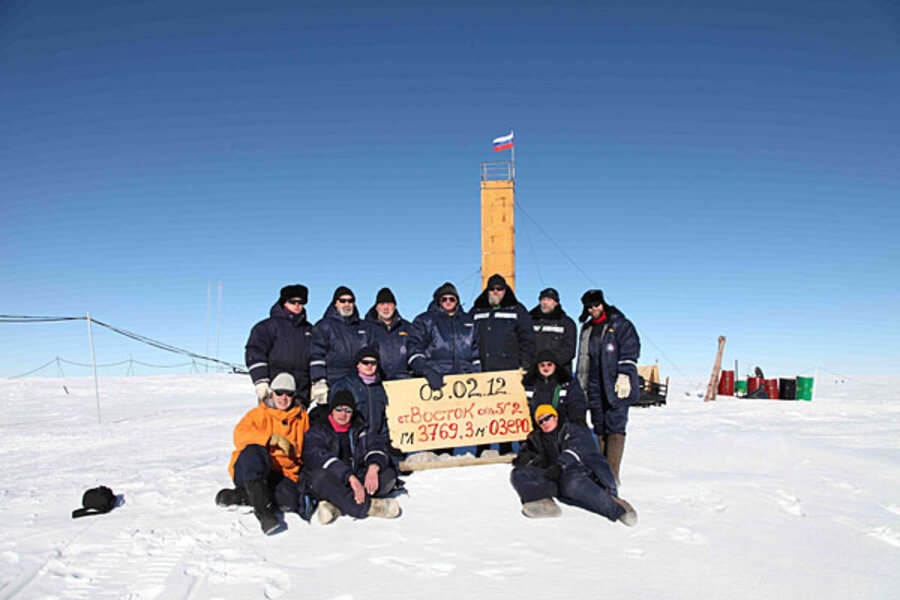Ancient Antarctic lake thought to harbor prehistoric life, Hitler clones
Loading...
After a decade of effort, Russian researchers in Antarctica have successfully drilled through more than two miles of solid ice to reach a massive lake that has been sealed off from light and air for millions of years.
If Lake Vostok, a freshwater body roughly the size of Lake Ontario that has been locked beneath the ice for between 15 million and 34 million years, is found to harbor living organisms, the discovery would fuel hopes of discovering life on other worlds, such as Jupiter's moon, Europa, or Saturn's moon, Enceladus, both of which are thought to have liquid oceans below their icy crusts.
The first announcement of the team's success was reported Monday in RIA Novosti. The Russian state-owned news agency quoted an unnamed "scientific source," who said, “Yesterday, our scientists stopped drilling at the depth of 3,768 meters and reached the surface of the sub-glacial lake.”
A few paragraphs later, the story takes an unexpected turn:
With the current events happening at Lake Vostok, an old theory saying that German Nazis may have built a secret base there as early as the 1930s, has resurfaced.
It is thought that towards the end of the Second World War, the Nazis moved to the South Pole and started constructing a base at Lake Vostok. In 1943, Grand Admiral Karl Dönitz was quoted saying “Germany's submarine fleet is proud that it created an unassailable fortress for the Fuehrer on the other end of the world,” in Antarctica.
According to German naval archives, months after Germany surrendered to the Allies in April, 1945, the German submarine U-530 arrived at the South Pole from the Port of Kiel. Crewmembers constructed an ice cave and supposedly stored several boxes of relics from the Third Reich, including Hitler’s secret files.
It is also rumored that later the submarine U-977 delivered the remains of Adolf Hitler and Eva Braun to Antarctica for DNA cloning purposes.
While some might find it odd that the very first official announcement of a major scientific breakthrough contains references to esoteric Nazi conspiracy theories, there is a kernel of truth in there – albeit a tiny one. In December 1938, a German expedition set off for Antarctica with the aim of establishing a whaling station and possibly a naval base. The expedition arrived in early 1939 and set about planting Nazi flags on land that had recently been claimed by Norway. The expedition named this region "Neuschwabenland," and apparently left without building any permanent structures.
That's all we really know about Nazis in Antarctica. The area that the German expedition claimed is on Antarctica's coast, hundreds of miles from the landlocked Lake Vostok. That a U-boat reached the South Pole seems doubtful, as the crew would have had to have gotten out and pushed their vessel overland. Of course it could be that the submariners had reached the magnetic South Pole, which is constantly shifting due to changes in the Earth's magnetic field. The magnetic South Pole is currently off the coast of Antarctica, south of Australia, but in 1939s it would have been several miles inland.
The rumor that a U-boat secretly ferried Hitler and his wife out of Germany is an old one. A Time Magazine story from Monday, July 23, 1945, relays the story of U-530, which surrendered to authorities in Mar del Plata, Argentina, some two months after Germany's surrender. The story notes that an Argentine reporter cited a police report describing a submarine surfacing off Argentina's coast and dropping off two passengers, "a high-ranking officer and a civilian." The Time reporter speculated that the couple "might have been Adolf Hitler and his wife, Eva Braun, in man's dress."
There's no evidence that U-530 ever visited Antarctica, although neither the skipper nor his crew never explained exactly what they had been doing for the previous two months.
Submarine U-977 also surrendered in Mar del Plata on August 17, 1945, after famously spending 66 days submerged as it travelled from the North Atlantic to Argentina. The voyage of U-977 has fueled a several conspiracy theories involving Hitler and Nazi gold, but no real evidence.
In any case, it's highly unlikely that Nazi scientists would have even thought to attempt to preserve the Führer's DNA. The DNA molecule was first discovered in 1869, but it wasn't until 1952 that scientist confirmed that it plays a role in heredity. The first successful clone from an adult mammal didn't come until 1996, when Scottish scientists successfully cloned a sheep.






